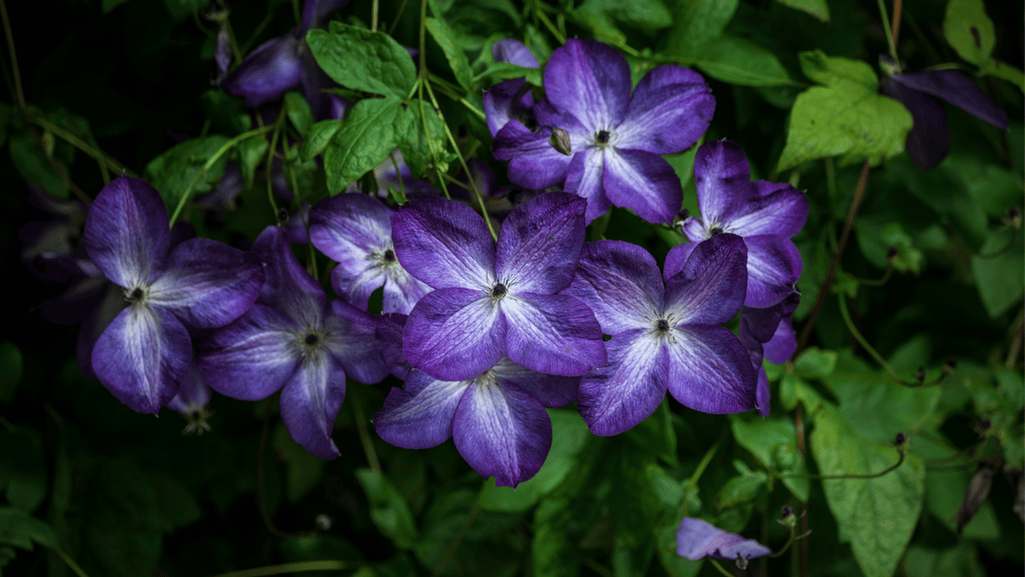
Beautiful flowers gardenia Plants For Your homes

Want a vibrant garden display that catches the eye? The Jackmanii clematis is perfect with its deep purple flowers. It’s a perennial vine that needs the right clematis care and growth tips to bloom well. With the right care, it turns your garden into a colorful scene among climbing plants.
By paying attention to its needs and pruning at the right time, the Jackmanii clematis becomes a standout in your garden. It adds beauty and makes your outdoor space more special.
The Jackmanii clematis varieties are known for their beautiful blue-purple flowers. They bloom a lot and are a favorite in gardens. They were created in the mid-1800s by crossing C. lanuginosa and C. viticella. This makes them great for both new and experienced gardeners.
This type of clematis – jackmanii grows well in USDA zones 4 through 8. It can grow 7 to 10 feet tall and spread 3 to 6 feet wide. In July, it blooms for a long time, showing off deep purple flowers that can change any garden.
| Characteristic | Detail |
|---|---|
| Preferred USDA Zone | 4 to 8 |
| Height | 7.00 to 10.00 feet |
| Spread | 3.00 to 6.00 feet |
| Bloom Time | July |
| Bloom Description | Blue-purple |
| Common Problems | Wilt, Powdery Mildew, Leaf Spots |
| Typical Uses | Climbing walls, trellises, arbors |
| Pot Material | Biodegradable coconut husk fibers |
The Jackmanii clematis is a great bloomer and a favorite in gardens. It can climb up trellises or cover large areas. But, it needs careful care to avoid problems like stem rot and pests.
Adding the Jackmanii clematis to your garden can make a big impact. It’s perfect for creating a dramatic look along fences or over arbors. Its beautiful and abundant blooms will surely impress everyone.
The name “clematis” comes from the Greek word klema, meaning vine or tendril. This shows how the clematis vine is known for climbing. The purple clematis is a mix of beauty and history, loved in gardens since medieval times.
Clematis plants are found in temperate regions of the Northern Hemisphere. They show a wide variety of species. The ornamental vine has grown over centuries, with over 400 species adding beauty to gardens worldwide.
Carl Linnaeus introduced clematis to the world in 1753 with Clematis viticella. Since then, many varieties have been added. Clematis ‘Jackmanii’ has been popular since 1862, showing how well the plant has adapted. Clematis patens from Japan and other large-flowered types show its magical and useful nature.
| Aspect | Detail |
|---|---|
| Origination Year | 1753 by Carl Linnaeus |
| Popular Varieties | Clematis ‘Jackmanii’, Clematis viticella |
| Visual Appeal | Purple clematis flowers, large and single |
| Bloom Season | February to fall |
| Symbolism | Ingenuity, artifice |
Clematis shows its diversity through regional names and cultural meanings. In Russian or Bulgarian, it’s called “traveler’s joy”. This shows the clematis vine not just makes gardens look good but also has deep meanings and history.
Finding the perfect spot for your garden might just lead you to the beautiful Jackmanii clematis. To make sure your garden is full of vibrant flowers, you need to know the best conditions for Jackmanii clematis growth. Picking the right spot in your garden is key to getting lots of blooms from this lovely vine.
When designing your garden, it’s important to balance sunlight and shade. Jackmanii clematis loves sunlight exposure to bloom well. But, it also needs some partial shade to keep cool and protect its roots. You can create shade by planting near trees or using garden structures that block the sun at certain times.
For Jackmanii clematis to grow well, the soil should be rich soil and keep moisture without getting too wet. Mulching is key here. Adding organic mulch helps keep the soil moist and healthy. Use things like bark or straw to keep the soil cool and moist around your plant.
Using these tips in your garden plan will help your Jackmanii clematis grow beautifully. A spot with morning sun and some afternoon shade, on fertile soil, is perfect. For more tips on caring for your clematis vines, check out this guide.
| Feature | Description | Benefits |
|---|---|---|
| Height Range | 7 ft to 10 ft | Ideal for trellises and fences |
| Flower Size | 4 inches | Stunning, large purple blooms |
| Light Requirements | Full sun to partial shade | Flexible planting options |
| Moisture Requirements | Moist, well-drained soil | Promotes healthy root growth |
| Resistance Characteristics | Deer, disease, heat, humidity, pests | Low maintenance and resilient |
Getting the best out of your Jackmanii clematis means choosing the right spot and taking good care of it. With the right care, it will be a beautiful part of your garden for many years.
Learning how to grow Jackmanii clematis starts with knowing the best planting depth and the value of soil enrichment. This clematis cultivar adds beauty to gardens with its lovely flowers. It also thrives with the right planting methods that help with plant health and climbing growth.
For a healthy vine, the depth and angle of planting Jackmanii clematis matter a lot. Dig a hole bigger than the root ball. Place the clematis at a 45-degree angle, with the crown 3 to 4 inches below the soil. This helps the plant climb well and grow strong roots, which is key for lots of blooms.
Good plant care means making the soil rich, which is vital for the Jackmanii clematis. Add compost and well-rotted manure to the hole, and use a balanced fertilizer like Espoma Rose-Tone. This makes the soil better and helps the clematis grow and flourish in its new home.
For more tips on planting and caring for Jackmanii clematis, check out Epic Gardening. It’s a great site that talks about sunlight, soil, and support systems for this type of clematis.
The Clematis ‘Jackmanii’ is a standout among large-flowered clematis. It’s a true marvel of horticulture. Known for its big purple blooms, up to nearly six inches wide, it brightens any garden.
This variety of Jackman clematis can grow 10 to 15 feet tall. It thrives in colder climates, starting from zone 4. Its strong nature and easy growth make it a top pick for garden plants. It fits well in many garden styles.
| Plant Type | Height | Flowering Season |
|---|---|---|
| Clematis ‘Jackmanii’ | 10-15 feet | Midsummer to early fall |
| Purple Wreath Vine | Up to 40 feet | Throughout summer |
| Purple Bell Vine | 10-12 feet | Late spring to late fall |
The Jackmanii stands out for its deep color and large flowers. George Jackman introduced it in the 19th century. It’s loved for its rich foliage and eye-catching blooms.
Compared to climbers like the Hyacinth Bean Vine, Clematis ‘Jackmanii’ shines. It’s not just a climber; it thrives. It adds life and color to trellises and walls in gardens.
Adding such vines to your garden boosts its look and brings in more life. With ‘Jackmanii’, you’re not just planting a vine. You’re creating a piece of art that shows nature’s beauty and human skill.
Proper care of Jackmanii clematis makes your garden vibrant and keeps your vines healthy. Following the right care instructions is key. It ensures your vines stay strong throughout their blooming cycle.
For thriving Jackmanii clematis, a consistent watering schedule is essential. These plants prefer soil that keeps moisture but doesn’t get too wet. In hot seasons, keep the soil moist but not waterlogged to avoid root diseases.
Mulching helps with moisture retention. A two to three-inch layer of organic mulch keeps the roots cool and moist. This is crucial for your clematis’s health.
Fertilizing is key for Jackmanii clematis growth and blooms. Use a balanced fertilizer like Espoma Rose-Tone three times a year for a lush bloom cycle. Fertilize in early spring and after each bloom cycle to get ready for the next growth.
This schedule makes sure nutrients are there when the plant needs them. It helps with flowering and developing strong vines.
| Fertilization Time | Product | Reason |
|---|---|---|
| Early spring | Espoma Rose-Tone | Supports initial spring growth |
| Post first bloom | Espoma Rose-Tone | Replenishes nutrients for health and vigor |
| Late fall, after final bloom | Espoma Rose-Tone | Prepares plant for dormancy |
By following these care tips, your clematis will thrive. It will have lush foliage and stunning blooms every year. Regular watering, moisture management, and a good fertilization plan keep your vines in top shape.
Learning how to prune Jackmanii clematis and other vines is key for getting lots of clematis flowers. Each type of clematis fits into one of three clematis pruning groups. These groups tell you how to prune for health and lots of blooms.
Clematis pruning groups are based on when they bloom and the type of wood that blooms. This helps you know how to prune:
Each group needs a different pruning method to grow and bloom well:
| Group | Pruning Time | Technique |
|---|---|---|
| 1 | Immediately after blooming | Remove dead and damaged stems; minimal cuts |
| 2 | Early spring and after first bloom | Moderate pruning to encourage a second flush of flowers |
| 3 | Late winter or early spring | Hard prune to a few buds above the base to ensure new growth |
Knowing the right pruning technique helps clematis vines stay healthy and bloom a lot. Regular pruning keeps the plants strong and looks good in your garden.
The clematis pruning groups guide you on how to care for them seasonally. For the best growth and blooms, use these pruning tips with good fertilizing, mulching, and keeping weeds away. With careful care and pruning, your clematis vines will do great, showing off their flowers year after year.
Adding Jackmanii Clematis to your garden design boosts beauty and makes your landscape enhancement more dynamic. This vine is perfect for many garden flowers and climbing plants. It adds depth and interest to any garden area.
Jackmanii Clematis thrives in full sun to partial shade and does well in a pH of 6.0 to 7.0. It fits easily into different garden spots and plant combinations. It can cover an old fence or decorate a trellis, making your garden more interesting.
Good garden design means choosing plant combinations that help plants grow and look better together. Pairing Jackmanii Clematis with roses and hydrangeas creates a better environment for all. Adding compost or peat moss to the soil helps these climbing plants and their friends grow well.
Jackmanii Clematis is great for making garden structures look beautiful. It works well on archways, trellises, or garden walls. Placing it right, with enough sunlight and good drainage, makes it bloom more. For more ideas, check out landscaping with Jackman’s Clematis.
In conclusion, Jackmanii Clematis is more than just a pretty plant. It brings life and color to your garden. It works well with other garden flowers and improves garden designs. It’s a top choice for gardeners who want beauty and function in their outdoor space.
Jackmanii clematis care needs careful attention to avoid planting mistakes. This easy care vine can grow well in your garden if you follow the right steps. Wrong practices can stop it from growing strong.
When you first plant your clematis, make sure to plant it deep. This helps the roots grow strong. Also, angle the plant a bit to help it stick to the support. Don’t put stones or too much mulch on top, as they block air and moisture to the roots.
After you plant, taking good care of your clematis is key. Cut the vine a bit after planting to make it focus on growing strong roots instead of flowers. This step is important for its health over time.
| Care Aspect | Benefits | Common Mistakes |
|---|---|---|
| Deep & Angled Planting | Promotes root development and vine stability. | Shallow planting, which may lead to poor root development. |
| Pruning Post-Planting | Helps focus energy on root system establishment. | Neglecting early pruning, leading to weak initial growth. |
| Mulching Practices | Conserves moisture and regulates soil temperature. | Excessive mulching, which restricts air and water flow. |
By following these tips, your easy care vine will be less likely to run into common problems. This ensures it will grow well and look great in your garden.
Ornamental vines like the Jackmanii clematis bring beauty and function to gardens. They grow well and have bright flowers. This climbing vine makes gardens look better and has many uses.
The Jackmanii clematis adds beauty with its vertical interest. Its big, purple flowers brighten gardens from summer to fall. It blooms from June to September, making it a key part of garden beauty.
This vine can grow up to 10 to 12 feet tall. It’s perfect for covering fences or trellises. Its growth makes it ideal for adding color and life to any garden.
The Jackmanii clematis is more than just pretty. It helps with privacy and hides garden flaws. It can cover fences or boxes, blending beauty with usefulness.
This makes it great for gardeners who want both looks and function. It’s a smart choice for anyone who gardens.
| Characteristic | Detail |
|---|---|
| Zone Suitability | Zones 4 to 8 |
| Size at Maturity | 12 feet tall, 24 inches wide |
| Sun Exposure | Full sun to part shade |
| Bloom Time | May to October |
| Pruning Group | Type 3 (Prune in spring) |
| Maintenance Level | Low |
| Potential Uses | Climbs structures, covers ground, container planting |
The Jackmanii clematis is essential for a great garden. It’s easy to care for and can be used in many ways. It’s both beautiful and practical, showing the best of garden design.
Garden lovers often wonder where to buy clematis, especially the popular Jackmanii type. It’s important to know the best places to look, like local garden centers, specialist nurseries, or online plant nurseries. This can greatly affect the quality and success of your garden.
When looking for Jackmanii clematis, you might wonder between local garden centers and specialist nurseries. Local centers have many plants, including clematis. But, they might focus more on general appeal than specialized care.
Specialist nurseries focus on plants that are healthy and well-developed. Places like Brushwood Nursery and Silver Star Vinery are known for their expert care and high-quality Clematis. They are a top choice for gardeners who want the best.
Online plant nurseries are a big help for gardeners looking for clematis. Sites like FastGrowingTrees.com are great for buying Jackmanii clematis. They offer a wide selection and deliver right to your door.
These sites also give detailed care tips. This helps gardeners make sure their plants thrive.
Today, gardeners have many ways to get high-quality Jackmanii clematis. You can choose between local garden centers, online nurseries, or specialist nurseries. Each option is important for your garden’s look and health. The right choice depends on what you prefer and your garden’s needs.
Since its introduction in 1862, the ‘Jackmanii’ Clematis has amazed gardeners with its impressive growth. It can grow up to 3 meters (10 ft) in one season. This plant flowers every year on new growth, offering a beautiful sight. It stands 200 – 400 cm (6.5 – 12.5 ft) tall and spreads 100 – 300 cm (3.5 – 10 ft).
This hardy plant thrives in various gardens, including those at Ballyrobert. It adapts to different soils and climates, showing its beauty and versatility. Gardeners need to know how to care for it to enjoy its vibrant flowers.
It takes about 2 to 5 years for the Jackmanii clematis to reach its full height. Knowing that different types bloom at different times helps gardeners plan their garden. This climber adds beauty and function to any garden.
Even after many years, mature Jackmanii vines still produce stunning flowers. Younger vines may have a harder time at first. But, with care, they can thrive. This shows how resilient these climbers are.
Patience and proper care are crucial for these plants. With over 300 species, Clematis has a long history. Each Jackmanii vine adds to the beauty of modern gardens. By following the right care tips, these flowers can be a lasting part of your garden.
